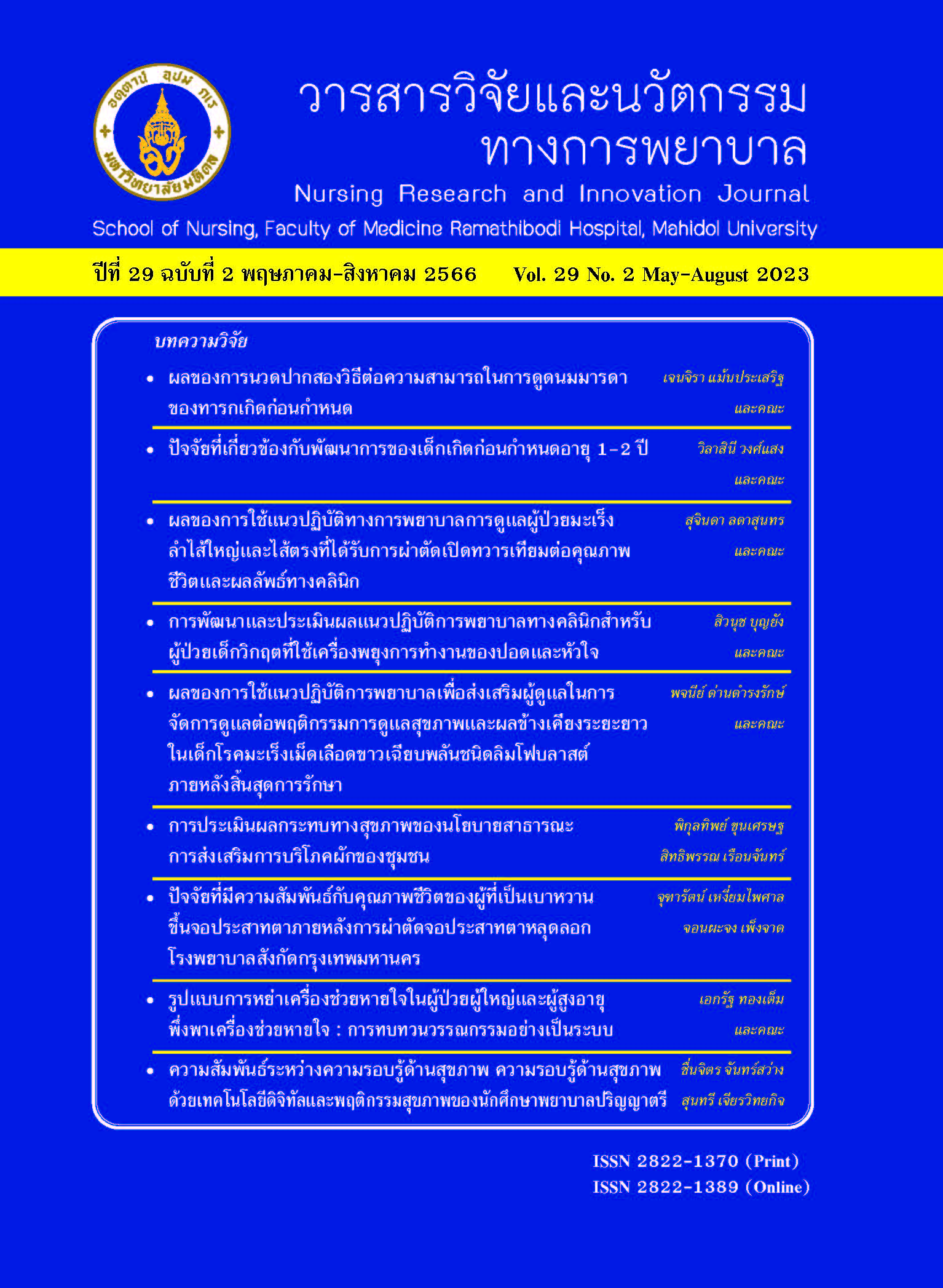ผลของการนวดปากสองวิธีต่อความสามารถในการดูดนมมารดาของทารกเกิดก่อนกำหนด
Main Article Content
บทคัดย่อ
การค้นหาระยะเวลาและจำนวนวันการนวดปากกระตุ้นการดูดกลืนในทารกเกิดก่อนกำหนดเป็นเรื่องที่น่าสนใจ การวิจัยครั้งนี้เป็นการวิจัยกึ่งทดลอง มีวัตถุุประสงค์เพื่อเปรียบเทียบความสามารถในการดููดนมมารดาของทารกเกิดก่อนกำหนด ระหว่างกลุ่มที่ 1 ที่ได้รับการนวดปากตามวิธีที่พัฒนามาจากเทคนิคของฟููไซด์และคณะ และกลุ่มที่ 2 ต ามวิธีของ เลสเซน ซึ่งใช้ระยะเวลาและจำนวนวันในการนวดปากแตกต่างกัน ความสามารถในการดููดนมมารดา ได้แก่ พฤติกรรมการดููดนมมารดา
ปริมาณน้ำนมที่ดููดได้ใน 5 นาทีแรก และจำนวนวันที่เปลี่ยนผ่านจากการได้รับนมทางสายยางไปเป็นการดููดนมได้เอง กลุ่มตัวอย่างเป็นทารกเกิดก่อนกำหนดที่มีอายุุหลังปฏิสนธิ 28-32 สัปดาห์เข้ารับการรักษาในหอผู้ป่วยทารกแรกเกิดโรงพยาบาลระดับตติยภููมิ 2 แห่ง จำนวน 34 ราย โดยการคัดเลือกแบบเฉพาะเจาะจงตามคุุณสมบัติที่กำหนดไว้ แบ่งกลุ่มตัวอย่างออกเป็น 2 กลุ่ม ๆ ละเท่ากันโดยวิธีการจับสลากแบบไม่แทนที่กลุ่มตัวอย่างฉลากเลขคี่ได้รับการนวดปากวิธีที่ 1 วันละ 1 ครั้ง ๆละ15 นาที ติดต่อกัน 10 วัน กลุ่มตัวอย่างฉลากเลขคู่ ได้รับการนวดปากวิธีที่ 2 วันละ 1 ครั้ง ๆละ 5 นาที ติดต่อกัน 7 วัน เมื่อทารกได้รับการกระตุ้น ครบตามกำหนดและแพทย์ทารกแรกเกิดลงความเห็นให้ทารกดููดนมจากเต้ามารดา ดูแลให้ทารกดููดนมมารดาเป็นเวลา 5 นาที ขณะเดียวกันสังเกตุุพฤติกรรมการดููดนมมารดโดยใช้แบบวัดพฤติกรรมการดูดนมมารดาของทารกแรกเกิดก่อนกำหนด ชั่งน้ำหนักทารกก่อนและหลังดูดนมมารดาเพื่อใช้คำนวนปริมาณน้ำนมที่ดููดได้ใน 5 นาทีแรก และนับจำนวนวันที่เปลี่ยนผ่านจากการได้รับนมทางสายยางไปเป็นการดููดนมได้เอง วิเคราะห์ข้อมูลโดยใช้สถิติ Mann-Whitney Test ผลการศึกษาพบว่า ความสามารถในการดูดนมมารดาของทารกเกิดก่อนกำหนดทั้ง 2 กลุ่ม ไม่มีความแตกต่างกันอย่างมีนัยสำคัญทางสถิติ ดังนั้นการนวดปากกระตุ้น การดูดกลืนในทารกเกิดก่อนกำหนดที่มีอายุุครรภ์น้อยกว่า 30 สัปดาห์ โดยวิธีที่ 2 ซึ่งใช้ระยะเวลาและจำนวนวันสั้นกว่า เป็นวิธีการกระตุ้น ที่ไม่มากเกินจำเป็น
คำสำคัญ : ความสามารถในการดููดนมมารดา การนวดปาก ทารกเกิดก่อนกำหนด
Article Details

อนุญาตภายใต้เงื่อนไข Creative Commons Attribution-NonCommercial-NoDerivatives 4.0 International License.
บทความ ข้อมูล เนื้อหา รูปภาพ ฯลฯ ที่ได้รับการตีพิมพ์ในรามาธิบดีพยาบาลสาร ถือเป็นลิขสิทธิ์ของวารสาร หากบุคคลหรือหน่วยงานใดต้องการนำทั้งหมดหรือส่วนหนึ่งส่วนใดไปเผยแพร่หรือเพื่อกระทำการใด ใด จะต้องได้รับอนุญาตเป็นลายลักษณ์อักษรจากรามาธิบดีพยาบาลสารก่อนเท่านั้น
เอกสารอ้างอิง
Schanler RJ, Shulman RJ, Lau C. Feeding strategies for premature infants: beneficial outcomes of feeding fortified human milk versus preterm formula. Pediatrics.1999;103(6 Pt 1):1150-7.
Gardner SL, Lawrence RA. Breast feeding the neonate with special needs. In: Gardner SL, Carter BS, Enzman-HinesM, Hernandez JA, editors. Merenstein & Gardner’s handbook of neonatal intensive care. 6th ed. St. Louis,Mosby Elsevier; 2011. p.434-81.
Simpson KR, Creehan PA. Perinatal nursing. 4th ed.Philadelphia: Wolters Kluwer/Lippincott Williams &Wilkins; 2014. p.633.
American Academy of Pediatrics. Breastfeeding and the use of human milk. Pediatrics. 2012;129(3):e827-41.
Herrmann K, Carroll K. An exclusively human milk dietreduces necrotizing enterocolitis. Breastfeed Med.2014;9(4):184–90.
Sullivan S, Schanler RJ, Kim JH, Patel AL, Trawoger R,Kiechl-Kohlendorfer U, et al. An exclusively human milk-based diet is associated with a lower rate of necrotizing enterocolitis than a diet of human milk and bovine milk-based products. J Pediatr. 2010;156(4):562-7.
Bharwani SK, Green BF, Pezzullo JC, Bharwani SS,Dhanireddy R. Systematic review and meta-analysis of human milk intake and retinopathy of prematurity: a significant update. J Perinatol. 2016;36(11):913-20.
Isaacs EB, Fischl BR, Quinn BT, Chong WK, Gadian DG,Lucas A. Impact of breast milk on intelligence quotient,brain size, and white matter development. Pediatr Res.2010;67(4):357-62.
Spatz DL. Ten steps for promoting and protecting breastfeeding for vulnerable infants. J Perinat Neonatal Nurs. 2004;18(4): 385-96.
Als H. Toward a synactive theory of development: promise for the assessment of infant individuality. Infant Ment Health J. 1982;3(4):229–43.
Nyqvist KH. Breastfeeding preterm infants. In: GennaCW, editor. Supporting sucking skills in breast feeding infants. 2nd ed. Burlington: Jones & Bartlett Learning;2013.p.171-196.
Nyqvist KH, Sjödén PO, Ewald U. The development of preterm infants’ breastfeeding behavior. Early Hum Dev.1999;55(3):247-64.
Saehoong S, Daramas T, Pookboonmee R. A systematicreview of oral stimulation to enhance sucking and swallowing in preterm infants. Rama Nurs J.2013;19(3):293-307. (in Thai)
Greene Z, O’Donnell CP, Walshe M. Oral stimulation for promoting oral feeding in preterm infants. Cochrane Database Syst Rev. 2016; 9(9):CD009720.
Fucile S, Gisel EG, Lau C. Oral stimulation accelerates the transition from tube to oral feeding in preterm infants.J Pediatr. 2002;141(2):230-6.
Lessen BS. Effect of the premature infant oral motor intervention on feeding progression and length of stay in preterm infants. [dissertation]. Bloomington, IL, Illinois Wesleyan University; 2008.
Boiron M, Da Nobrega L, Roux S, Henrot A, Saliba E.Effects of oral stimulation and oral support on nonnutritive sucking and feeding performance in preterm infants. Dev Med Child Neurol. 2007;49(6): 439-44.
Gaebler CP, Hanzlik JR. The effects of a prefeeding stimulation program on preterm infants. Am J Occup Ther.1996;50(3):184-92.
Rendón-Macías ME, Cruz-Perez LA, Mosco-Peralta MR, Saraiba-Russell MM, Levi-Tajfeld S, Morales-López MG. Assessment of sensorial oral stimulation in infants with suck feeding disabilities. Indian J Pediatr.1999;66(3):319-29.
Hwang YS, Lin CH, Coster WJ, Bigsby R, Vergara E.Effectiveness of cheek and jaw support to improve feeding performance of preterm infants. Am J Occup Ther.2010;64(6):886-94.
Harding C, Law J, Pring T. The use of non-nutritive sucking to promote functional sucking skills in premature infants: an exploratory trial. Infant. 2006;2:238-43.
Beckman D. Beckman Oral Motor; [cited 2017 May 19].Available from: https://www.beckmanoralmotor.com/workshops/course-descriptions.php
Fucile S, Gisel EG, Lau C. Effect of an oral stimulation program on sucking skill maturation of preterm infants.Dev Med Child Neurol. 2005;47:158-62.
Rocha AD, Moreira ME, Pimenta HP, Ramos JR, Lucena SL. A randomized study of the efficacy of sensory-motororal stimulation and non-nutritive sucking in very low birth weight infant. Early Hum Dev. 2007;83(6): 385-8.
Pruksadee N, Daramas T, Phumolsakul S. Effect of the premature infant oral motor intervention on the transition time from tube to oral feeding and body weight. Rama Nurs J. 2017;23(3):257-68. (in Thai)
Kingnala S, Klunklin P, Urharmnuay M. Effects of oral stimulation on preterm infants’ breastfeeding behavior.Nursing J. 2017;44(supplement1):128-37. (in Thai)
Pimenta HP, Moreira ME, Rocha AD, Gomes SC Jr, Pinto LW, Lucena SL. Effects of non-nutritive sucking and oral stimulation on breastfeeding rates for preterm, low birth weight infants: a randomized clinical trial. J Pediatr(Rio J). 2008;84(5):423-7.
Sanitlou N, Sartphet W,Naphaarrak Y. Sample size calculation using G*power program. J of Suvarnabhumi Tech. 2019;5(1):496-507.
Lessen BS. Effect of the premature infant oral motor intervention on feeding progression and length of stay in preterminfants. Adv Neonatal Care. 2011;11(2):129-39.
Papana N, Klunklin P, Soontornchai P. Effect of pacifier sucking during orogastric feeding on preterm infant’s breastfeeding. Nursing J. 2011;38(1):74-84. (in Thai)
Rearkyai S, Daramas T, Kongsaktrakul C. Effect of oral stimulation on feeding efficiency in preterm infants. Thai J Pediatr. 2014;21(3):17-22. (in Thai)
Narayanan I, Mehta R, Choudhury DK, Jain BK. Sucking on the “emptied” breast-non-nutritive sucking with a difference. Arch Dis Child. 1991; 66: 241-4.
Bingham PM, Abassi S, Sivieri E. A pilot study of milk odor effect on nonnutritive sucking by preterm newborns.Arch Pediatr Adolesc Med. 2003;157:72-5.


